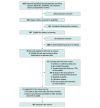Factors Associated With Burnout and Stress in Trainee Physicians: A Systematic Review and Meta-analysis
- PMID: 32809031
- PMCID: PMC7435345
- DOI: 10.1001/jamanetworkopen.2020.13761
Factors Associated With Burnout and Stress in Trainee Physicians: A Systematic Review and Meta-analysis
Abstract
Importance: Evidence suggests that physicians experience high levels of burnout and stress and that trainee physicians are a particularly high-risk group. Multiple workplace- and non-workplace-related factors have been identified in trainee physicians, but it is unclear which factors are most important in association with burnout and stress. Better understanding of the most critical factors could help inform the development of targeted interventions to reduce burnout and stress.
Objective: To estimate the association between different stressors and burnout/stress among physicians engaged in standard postgraduate training (ie, trainee physicians).
Data sources: Medline, Embase, PsycINFO, and Cochrane Database of Systematic reviews from inception until April 30, 2019. Search terms included trainee, foundation year, registrar, resident, and intern.
Study selection: Studies that reported associations between stressors and burnout/stress in trainee physicians.
Data extraction and synthesis: Two independent reviewers extracted the data and assessed the quality of the evidence. The main meta-analysis was followed by sensitivity analyses. All analyses were performed using random-effects models, and heterogeneity was quantified using the I2 statistic.
Main outcome and measures: The main outcome was the association between burnout/stress and workplace- or non-workplace-related factors reported as odds ratios (ORs) and their 95% CIs.
Results: Forty-eight studies were included in the meta-analysis (n = 36 266, median age, 29 years [range, 24.6-35.7 years]). One study did not specify participants' sex; of the total population, 18 781 participants (52%) were men. In particular, work demands of a trainee physician were associated with a nearly 3-fold increased odds for burnout/stress (OR, 2.84; 95% CI, 2.26-3.59), followed by concerns about patient care (OR, 2.35; 95% CI, 1.58-3.50), poor work environment (OR, 2.06; 95% CI, 1.57-2.70), and poor work-life balance (OR, 1.93; 95% CI, 1.53-2.44). Perceived/reported poor mental or physical health (OR, 2.41; 95% CI, 1.76-3.31), female sex (OR, 1.34; 95% CI, 1.20-1.50), financial worries (OR, 1.35; 95% CI, 1.07-1.72), and low self-efficacy (OR, 2.13; 95% CI, 1.31-3.46) were associated with increased odds for burnout/stress, whereas younger age and a more junior grade were not significantly associated.
Conclusions and relevance: The findings of this study suggest that the odds ratios for burnout and stress in trainee physicians are higher than those for work-related factors compared with nonmodifiable and non-work-related factors, such as age and grade. These findings support the need for organizational interventions to mitigate burnout in trainee physicians.
Conflict of interest statement
Figures



Comment in
-
Factors Associated With Trainee Physician Burnout-Where Should the Focus Be?JAMA Netw Open. 2020 Aug 3;3(8):e2014345. doi: 10.1001/jamanetworkopen.2020.14345. JAMA Netw Open. 2020. PMID: 32809026 No abstract available.
References
-
- The British Medical Association Doctors' titles: explained. 2017. Accessed July 21, 2019. https://www.bma.org.uk/advice-and-support/international-doctors/life-and...
Publication types
MeSH terms
Grants and funding
LinkOut - more resources
Full Text Sources
Miscellaneous

